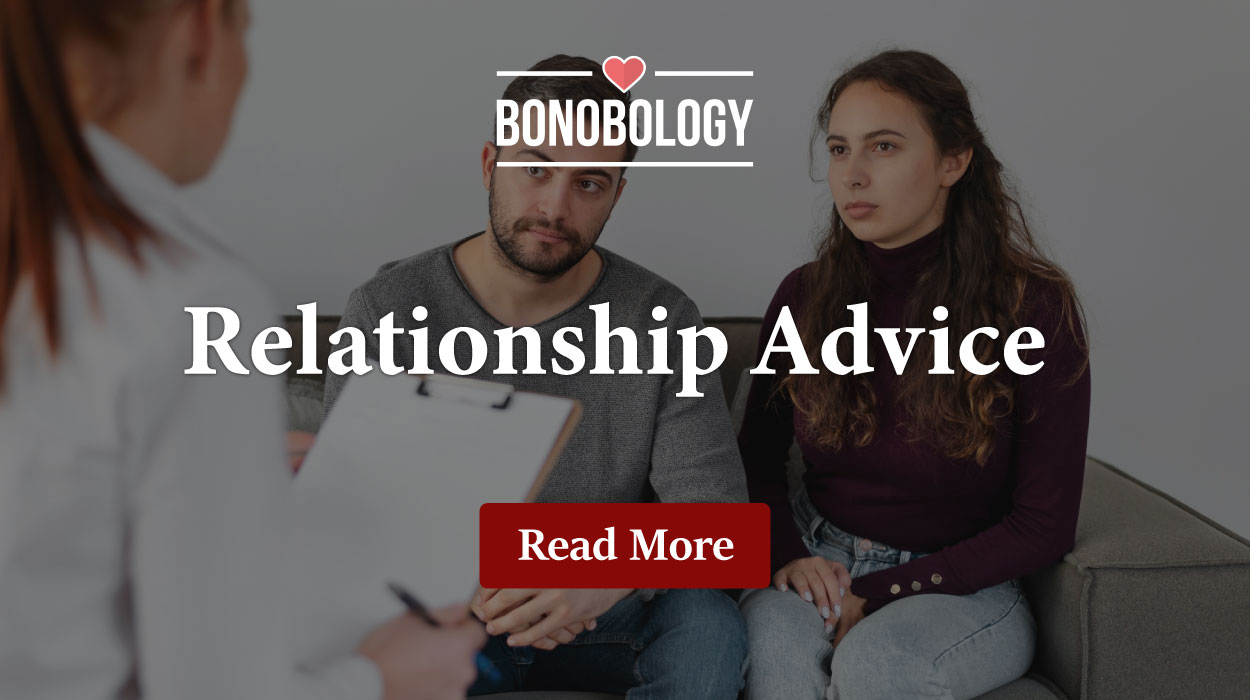Lust vs love — it can be hard to tell the difference between these two tantalizing tango partners that often leave us in a whirlwind of emotions. Passionate love is like a slow-burning campfire, radiating warmth and comfort throughout your body. It’s a fire you nurture and watch grow over time.
On the other hand, lust is like wildfire, sparked by intense sexual attraction and fueled by sexual satisfaction. It’s a fire that can burn bright and hot but quickly fade away. Considering how similar the two feelings are, especially in the beginning, it is no surprise most people have a tough time making out the difference between love and lust.
Have you, too, at some point found yourself wondering, “Is it lust or love?” Are you wrestling with a similar dilemma right now as you struggle to make sense of your feelings for someone? Rest easy, we’re here to help you find a way of out this confusion. As you travel through these 8 ways to differentiate between lust and love, you will be able to tell whether you’re experiencing a passionate love or a fleeting physical attraction.
What Is Lust?
Table of Contents
On the meaning of lust, American writer and theologian Frederick Buechner wrote, “Lust is the craving for salt of a man who is dying of thirst.” Quite an apt description of what lust is. It is an emotion defined as a strong, intense, obsessive desire for someone or something, and is rooted in our primal instincts. It is a natural human response to attraction and the need for physical intimacy.
While lust may seem like it’s just about sexual gratification, it is also based on an all-consuming attachment and fleeting emotions. It can inspire us to do great things or lead us down a path of destruction, which, again, is how love feels in the beginning — making it difficult to decipher whether what you are feeling is lust or love.

Relationship experts state that lust has evolved as an adaptive response to encourage us to seek out sexual partners and reproduce. Its experience is associated with the release of dopamine and other feel-good neurotransmitters in the brain.
However, the potential adverse effects of experiencing lust, such as an addiction to being with someone for sexual fulfillment, suggest that it can be a double-edged sword. The silver lining, however, is that an understanding of these adverse effects can help you tell the difference between love and lust.
Related Reading: How To Know If He Loves You Or Lusts You
10 Signs Of Lust
Now that we know the meaning of lust and that it tends to be more focused on physical attraction and desire, we will explore the tell-tale signs of lust, shedding light on the more fleeting and immediate aspects of romantic connection:
- Physical attraction dominates: Lust is often characterized by a strong emphasis on physical appearance. If you find yourself primarily drawn to someone’s looks rather than their personality or character, it could be a sign that lust is at play
- Immediate intensity: Lust tends to be intense from the outset. If the passion is burning brightly right from the beginning, it may indicate that the emotions are more rooted in lust than in the gradual development of deeper feelings
- Focus on the sensual: Lust is inherently sensual, and if the relationship revolves around physical gratification rather than emotional connection, it’s likely driven by lust. This can manifest as an emphasis on sexual attraction over emotional intimacy
- Limited emotional connection: Lust often lacks the depth of emotional connection that is a hallmark of love — a key lust vs love difference. If conversations are predominantly surface-level and there’s a reluctance to delve into more profound aspects of each other’s lives, it may signify a focus on lust
- Short-term outlook: Lust tends to be more short-term and immediate in its goals. If the relationship is primarily about satisfying immediate desires without much thought for the future, it’s an indicator of lust rather than long-term love
- Fantasy-focused: Lust often involves idealized fantasies about the other person. If the relationship is more about an imagined perfect scenario rather than the reality of the person, it’s likely rooted in lustful desires
- Intensity fades quickly: Lustful intensity can burn out swiftly. If the initial spark diminishes rapidly and there’s a lack of interest in building a deeper connection, it’s a sign that the emotions were driven by lust rather than a lasting bond
- Limited interest in personal growth: Love often involves supporting each other’s personal growth and development. In a lust-driven relationship, the focus may be more on the present moment, with less interest in the long-term aspirations and personal evolution of the partner
- Physical proximity is key: If the relationship relies heavily on physical proximity and struggles when apart, it may indicate a more superficial connection based on lust rather than a robust emotional bond
- Jealousy over possession: Lust can evoke possessive feelings but these are often based on physical possession rather than a genuine concern for the well-being and happiness of the other person. If jealousy centers around physical appearances or attention from others, it’s likely rooted in lust
What Is Love?
If you’re struggling to answer the question, “Am I in love?”, you’re not alone. How do you know if you’re in love with someone is a question that has confused people since the beginning of time, and can leave some paralyzed with indecision. While there is no single definition of love and attachment, there are some key characteristics that are commonly associated with this powerful emotion and can help you distinctively understand the lust vs love difference.
At the heart of romantic love is a feeling of deep affection and connection with another person. This can take many forms, from physical intimacy to emotional closeness, but it is a fundamental aspect of the romantic love experience. Which answers your question, “How do you know you’re in love?”
If you’re wondering, “What does it mean to love someone?”, the simplest answer is: to love is to take a risk. To put ourselves in a vulnerable position, opening ourselves up to rejection and heartbreak from a deep attachment. This element of risk is a fundamental part of the romantic love experience, and it can make it all the more rewarding when things work out.
Falling in love can be a transformative experience that changes how we see ourselves and the world around us. It can inspire us to be more compassionate, more generous, and more forgiving, and it can help us to grow and evolve as individuals. This is how most people describe true feelings of love and figure out whether what they’re feeling is lust or love.
Related Reading: 10 Signs From The Universe That Love Is Coming Your Way
10 Signs Of Love
So, how do you know you’re in love? Distinguishing genuine love from more fleeting emotions can be complex, but certain signs can help illuminate the depth and authenticity of one’s feelings. In this section, we delve into the subtle yet powerful signs you’re in love, providing insight into the enduring aspects that go beyond the initial allure.
- Emotional security: Love fosters a sense of emotional security. If you feel comfortable being your true self, sharing vulnerabilities, and expressing your deepest thoughts without fear of judgment, it signifies a foundation built on love
- Mutual respect: Respect is a cornerstone of love. When both partners genuinely value each other’s opinions, boundaries, and individuality, it indicates a love that goes beyond mere infatuation
- Long-term commitment: Love involves a commitment to the future. If there is a shared vision, plans for the long term, and a willingness to weather challenges together, it reflects a deep, enduring love
- Effective communication: Love thrives on open and honest communication. If both partners can express themselves freely, actively listen, and work through disagreements constructively, it is a testament to a mature and lasting love
- Supportive growth: True love encourages personal and mutual growth. If your partner supports and encourages your aspirations and self-improvement, it demonstrates a love that transcends the immediate and embraces the journey of personal development.
- Intimacy beyond the physical: While physical intimacy is essential, love goes beyond the purely physical. Emotional intimacy, intellectual connection, and shared values are all signs you’re in love
- Shared laughter and joy: Laughter is a powerful indicator of love. If you find joy in each other’s company, share laughter even in challenging times, and cherish moments of happiness together, it signifies a love that can withstand the test of time
- Unconditional acceptance: Love involves accepting each other wholly, flaws and all. If your partner’s imperfections do not diminish your love but rather add to their uniqueness, it’s a sign of a love that transcends superficial expectations
- Prioritizing each other’s well-being: In a loving relationship, both partners prioritize each other’s happiness and well-being. If there is a genuine concern for each other’s welfare and a willingness to make sacrifices for the other’s benefit, it reflects a deep and selfless love
- Emotional resilience: Love provides a foundation for emotional resilience. When faced with challenges, a loving couple can navigate difficulties with a united front, drawing strength from their emotional connection and commitment to each other

Lust vs Love – 8 Ways To Differentiate
So, is it lust or love? Differentiating between lust and love is more complicated than knowing whether it’s just sex or genuine love that you desire. Read along to find out the key differentiators of love and lust:
1. The emotional intensity of love and lust
What is the difference between lust and love? Lust is characterized by intense feelings of excitement and desire that can be overwhelming and difficult to control, while love is steadier and more consistent.
- Some tell-tale signs of lust are being unable to stop thinking about the other person, particularly in a sexual way, and a lack of interest in non-sexual conversations or building a real connection with them
- Love, on the other hand, may involve a more balanced approach to sexual and emotional connection
2. Perception of your partner: One of the key love and lust differences
Love is about accepting a person’s flaws and seeing them as they are rather than an idealized version of them. On the other hand, lust may cause you to ignore or downplay a partner’s or romantic interest’s flaws and solely focus on the physical aspects of the relationship.
Related Reading: Platonic Relationship Vs Romantic Relationship – Why Are Both Important?
3. Enduring love vs ephemeral lust
Is it lust or love? Enduring love involves a deep emotional connection that grows over time, beyond physical attraction. It is characterized by a desire to support, respect, and care for the other person, even during difficult times. Ephemeral lust, on the other hand, is primarily driven by physical attraction and excitement and can fade away once that initial spark subsides.
- Love endures even as physical attraction fades or other challenges arise
- Lust, on the other hand, may fizzle out once the novelty or excitement wears off, leaving little to sustain the relationship
- Understanding this key difference between lust and love can help you build strong, healthy relationships in the long run
4. Love vs lust difference lies in long-term goals
You may be wondering, “Am I in love? Or is this simply lust?” Love and lust both involve feelings of attraction but they represent different facets of human desire. Love entails a deep, emotional connection that often involves a desire for a long-term commitment, building a life together, and creating a meaningful partnership. Lust, on the other hand, is focused on the physical and sexual aspects of a relationship, and may not involve a commitment beyond the immediate gratification of those desires.

5. Difference in attitude and behavior
What is the difference between lust and love? The way we behave in a relationship can reveal a lot about our intentions and desires. When it comes to love and lust, the differences in behavior can be striking. Lust often leads to impulsive and self-centered behavior, where the focus is on immediate physical gratification. Love, on the other hand, is characterized by thoughtful and intentional behavior, with an emphasis on building a deep and lasting connection with the other person.
6. Emotional openness, vulnerability, and Intimacy
If you’re still asking yourself, “Am I in love?”, consider how you communicate with the other person. When you can communicate honestly and authentically with your partner or a romantic interest, you create a foundation of trust and mutual respect that can help your relationship thrive.
- In love, you open up to your partner, sharing your innermost thoughts and feelings, and creating a deep and meaningful connection based on trust and mutual understanding
- In lust, however, the focus is often more on establishing a physical connection, and emotional vulnerability and intimacy may either be completely missing or not as strong as they need to be for building a sustainable bond
Related Reading: 21 Differences Between Love And Infatuation
7. Physical sensations and reactions
Physical sensations and reactions can be powerful indicators of the difference between love and lust. Here are some indicators to keep in mind:
- Physical symptoms such as increased heart rate, sweating, and dilated pupils are often signs of lust
- Love, in contrast, is often characterized by feelings of emotional safety, security, and contentment
- Understanding the physical and emotional differences between lust and love can help you make more informed decisions about your relationships. If you’re getting signs he wants you badly or signs she can’t keep her hands off you, chances are it’s pure lust
8. Selflessness and compromise
Selflessness and compromise are often considered hallmarks of a loving relationship, as partners prioritize each other’s needs and make decisions with their partner’s best interests in mind. In love, this kind of selflessness comes naturally, as the emotional connection between partners encourages them to put each other first.
In lust, however, the focus is often more self-centered, as partners prioritize their own desires over their partner’s needs. Recognizing the distinction between sacrifice and self-interest can help you establish more mutually supportive relationships over time.
If you are still unsure where your heart lies, try this lust vs love quiz.

Key Pointers
- Differentiating between love and lust can lead to stronger and more fulfilling relationships in the long term
- When you are clear about your own goals and expectations, you are better equipped to navigate the nuances of your desires and pursue relationships that align with your values and aspirations
- Whether you are seeking love or lust, being honest with yourself about what you truly want is the key to creating fulfilling relationships
- Understanding the physical and emotional disparities between love and lust can aid you in making better-informed decisions regarding your relationships.
It’s essential to understand the differences between love and lust to make informed decisions about your relationships. By taking the time to understand your feelings and needs, as well as the meaning of lust, you can better navigate your romantic connections and create fulfilling relationships.
Ultimately, it’s up to you to determine what you are looking for in a relationship, be it lust or love and what will make you happy. Don’t be afraid to take the time to explore your feelings and to communicate openly with your partner about what you are looking for, to build a deeper connection. Whether you are experiencing love or lust, both emotions have their place and can lead to fulfilling relationships at the stage you desire, it’s not about love vs lust and which feeling is the correct or appropriate one.
20 Questions To Build Emotional Intimacy And Bond With Your Partner On A Deeper Level
Your contribution does not constitute a charitable donation. It will allow Bonobology to continue bringing you new and up-to-date information in our pursuit of helping anyone in the world to learn how to do anything.



Featured
Why Do I Want To Bite My Boyfriend? The Psychology Behind It
Ungodly Soul Ties Keeping You Stuck? Learn How To Break Them
How To Feel Confident During Your First Sex Experience
200+ Creative Responses To “I Love You”
15 Things to Consider Before Making a Relationship Official
How To Make Him Obsessed With You: 21 Smart Tips
10 Best Apps for Long-Distance Relationships
21 Signs You Have An Unexplainable Connection With Someone
150 Words Of Affirmation Examples To Cement Your Bond
7 Obvious Signs He Likes You, As Per A Relationship Expert
How To Manifest Someone To Be Obsessed With You
100 Romantic Birthday Wishes To Make Your SO’s Day Extra Special
200 Romantic Text Messages That Will Make Her Want You Badly
How To Make It Up To Your Girlfriend: 20 Effective Ideas
Emoji Love Texts: 15 Creative Ways to Express Your Feelings
30 Romantic Emoji Meanings — Decoded for You
100 Things for Couples to Do Together
20 Signs of True Love From A Man
How Long Does The Honeymoon Phase Last?
125 Sweet Things To Say To Your Wife In A Text